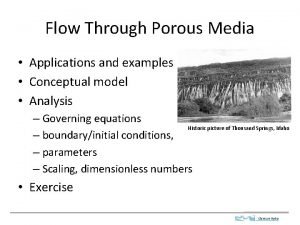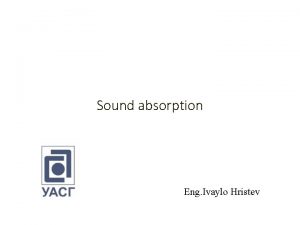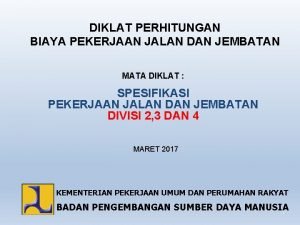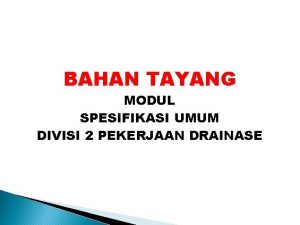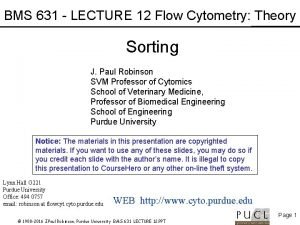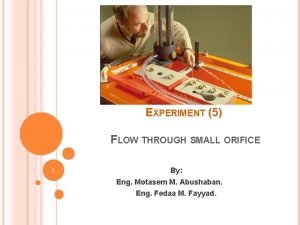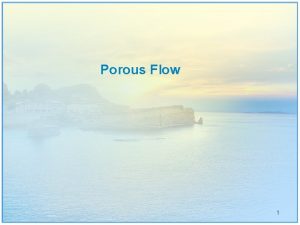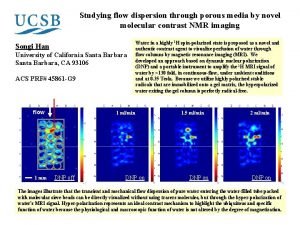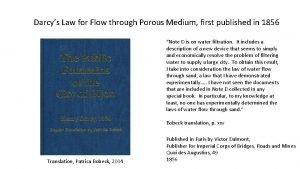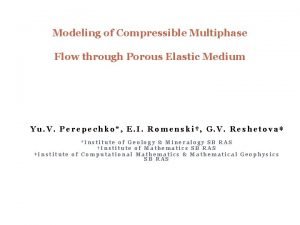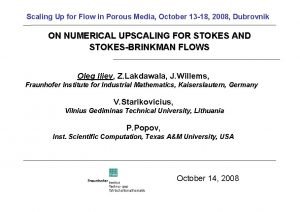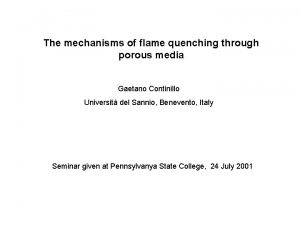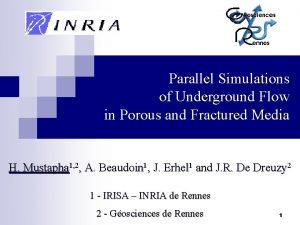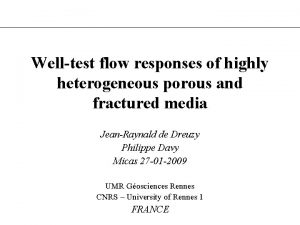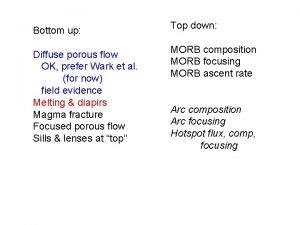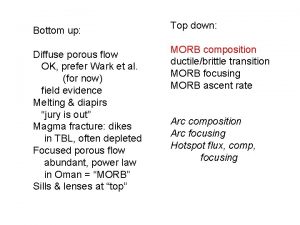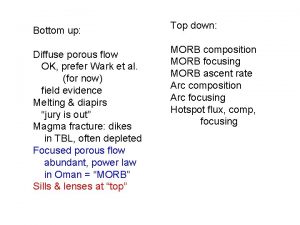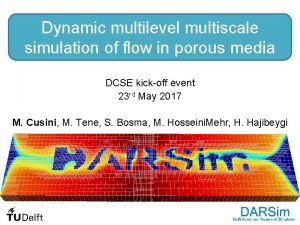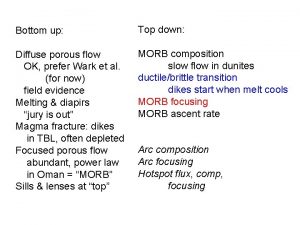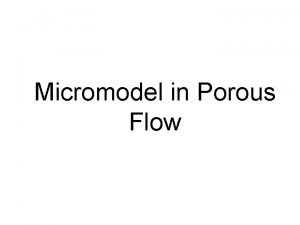Lecture 19 and 20 Flow through porous media





![Darcy’s Experiment 1 q L 2 A K is the hydraulic conductivity K [=] Darcy’s Experiment 1 q L 2 A K is the hydraulic conductivity K [=]](https://slidetodoc.com/presentation_image_h/8bd2effc77bc9f9049b321708788cac0/image-6.jpg)



![Darcy’s Law q is the volumetric flow rate q [=] cm 3/s q/A = Darcy’s Law q is the volumetric flow rate q [=] cm 3/s q/A =](https://slidetodoc.com/presentation_image_h/8bd2effc77bc9f9049b321708788cac0/image-10.jpg)
















- Slides: 26

Lecture 19 and 20 Flow through porous media

History A lovely picture of Henry Darcy (1856)

Darcy’s Experiment water q 1 h 1 L h 2 2 atm

Hydraulic Head (h) Energy of a stationary liquid b y 1 Head = potential energy + pressure For this case: h 1 = h 2 Why? y 2

Head Loss Energy loss of liquid For steady moving viscous flow: Friction loss h 1 -h 2 = head loss = friction loss
![Darcys Experiment 1 q L 2 A K is the hydraulic conductivity K Darcy’s Experiment 1 q L 2 A K is the hydraulic conductivity K [=]](https://slidetodoc.com/presentation_image_h/8bd2effc77bc9f9049b321708788cac0/image-6.jpg)
Darcy’s Experiment 1 q L 2 A K is the hydraulic conductivity K [=] L/t Darcy’s law can be interpreted as a momentum, or as an energy equation

Generalization to nonvertical flow q Elevation datum L b A 2 1 z 2

Generalization to nonvertical flow

Definition of permeability, k Nutting (1930) found K ~ 1/ k is the intrinsic permeability k [=] L 2
![Darcys Law q is the volumetric flow rate q cm 3s qA Darcy’s Law q is the volumetric flow rate q [=] cm 3/s q/A =](https://slidetodoc.com/presentation_image_h/8bd2effc77bc9f9049b321708788cac0/image-10.jpg)
Darcy’s Law q is the volumetric flow rate q [=] cm 3/s q/A = u is the flux velocity also called the linear velocity q/A [=] cm/s

Flux velocity and interstitial velocity Flux velocity Velocity of liquid averaged over total volume Interstitial velocity Velocity of liquid averaged over void volume (measures velocities in the pores)

How good is Darcy’s law? q potential kinetic Pay attention when you deviate from: • steady state • homogeneous material • incompressible fluid • average flow velocity Darcy flow Non-Darcy flow dp/ds

Units for k 1 cm 3 cube/s 1 darcy = 10 -12 m 2 1 atm =1 cp k=1 darcy 1 md = 10 -15 m 2

Oilfield units k in md is specific gravity in cp is dip angle q in STB/day dp/ds is psi/ft B in res bbl/STB

Horizontal Flow q x For horizontal flow s=x:

Vertical Flow through Core air 1 q 2 air p 1 = p 2 = patm= 0 psig

Vertical Flow with Driving Head b 1 L q 2

Upward Vertical Flow q L b

Radial Flow of a Production Well q rw re • s is the direction of flow • r is from well to the boundary

Radial Flow of a Production Well q rw re Can we now integrate?

Radial Flow of a Production Well A is a function of r r bb q re q constant for steady state

Radial Flow of a Production Well

Extension to heterogeneous systems Parallel beds q 1 k 1 b 1 q 2 k 2 b 2 q 3 k 3 b 3 L How to compute total q ? b w

Set up Darcy’s law for each layer q 1 k 1 b 1 q 2 k 2 b 2 q 3 k 3 b 3 L b w

Extension to heterogeneous systems Series of beds Δp 1 Δp 2 Δp 3 L 1 L 2 L 3 q Show that

Extension to heterogeneous systems Why are they so different? Δp 1 q 1 k 1=500 b 1=10 q 2 k 2=0. 01 b 2=1 q 3 k 3=10 b 3=5 Δp 2 Δp 3 b q k 1=500 L 1=10 k 3=10 k 2=0. 01 L 2=1 L 3=5 w L Does this seem realistic to you?
 Free and porous media flow comsol
Free and porous media flow comsol List of symbols
List of symbols Types of porous absorbers
Types of porous absorbers Bahan drainase porous atau penyaring (filter)
Bahan drainase porous atau penyaring (filter) Objective of tig welding
Objective of tig welding Porous material
Porous material Shaud tavakoli
Shaud tavakoli Bahan drainase porous atau penyaring (filter)
Bahan drainase porous atau penyaring (filter) 01:640:244 lecture notes - lecture 15: plat, idah, farad
01:640:244 lecture notes - lecture 15: plat, idah, farad Advantages and disadvantages of tangential sawing
Advantages and disadvantages of tangential sawing Flow cytometry lecture
Flow cytometry lecture By one man sin
By one man sin Dome of furcation
Dome of furcation My mother twisted through and through
My mother twisted through and through Lecture about social media
Lecture about social media Structure chart in software engineering
Structure chart in software engineering Transform flow and transaction flow
Transform flow and transaction flow Rotational and irrotational flow examples
Rotational and irrotational flow examples Internal flow and external flow
Internal flow and external flow Control flow and data flow computers
Control flow and data flow computers Laminar and turbulent flow
Laminar and turbulent flow What is people
What is people Basic flow of funds through the financial system
Basic flow of funds through the financial system River shannon
River shannon Journey down the mekong
Journey down the mekong Flow through an orifice lab report discussion
Flow through an orifice lab report discussion How does energy flow through an ecosystem
How does energy flow through an ecosystem

